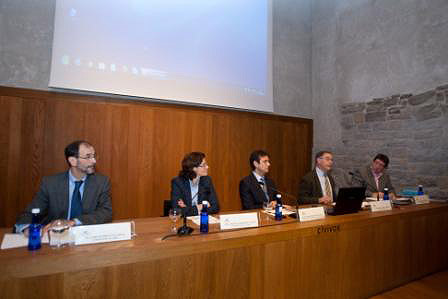26 November 2014
Global Seminars & Invited Speaker Series
HERITAGE AND SPEECH. A FRAMEWORK DE REFERENCE LETTER
roundtable: speech and dissemination of Cultural Heritage
Ms. Fina Trèmols i Garanger
Vice-Rector's Office speech. University of Navarra
The Chair of Heritage and Art of Navarre of the University of Navarra closed yesterday the lecture series on "Heritage and speech" with a roundtable, in the Palacio del Condestable, in which were present: Román Felones, president of the committee social of the Public University of Navarre; Mónica Herrero, dean of the School of speech of the University of Navarre; Carlos Erce, director general of Tourism and Commerce, and Fernando Hernández, editor-in-chief of Diario2 of Diario de Navarra. They were moderated by Ricardo Fernández Gracia, director of the Chair de Patrimonio y Arte Navarro.
Román Felones highlighted the value of Navarre's heritage: "50 km around, wherever you live, you can find pieces from the Romanesque, Gothic, Renaissance and Baroque periods". He stressed the importance of institutional commitment to safeguarding it and the need to train teachers, who are the transmitters of all this information that has to be passed on to the next generation. He pointed out that the speech of heritage to the world of children is "little explored; children must be accompanied and the speech must be adapted to them. However, "there is a lack of teaching materials for primary and secondary school students", he concluded.
For her part, Mónica Herrero added that "heritage communicates in itself and can be considered one of the most important means of speech "; she stressed that "the professionals of the speech, with their work, can communicate heritage, bringing us closer to our cultural heritage, to our history, with their stories. The audiovisual fiction "Indiana Jones", for example, made the social image of the archaeologist grow considerably".
In order to communicate heritage, it is essential to create a story, which helps and facilitates the questioning of the piece itself and brings it closer to the present", said Fernando Hernández, who showed the audience different ideas of books through which this story can be created. This is the case of "The history of the world in 100 objects", by Neil Mac Gregor, or the "Dictionary of the saints", which help the reader to recognise them. Ricardo Fernández Gracia took the opportunity to note that "reading references have been lost. You can't go out and live with the space if you don't know how to read the heritage".
Carlos Erce closed the speeches. He pointed out that cultural tourism has facilitated the meeting between tourism and heritage, as "the tourist does not only have one single interest". He highlighted the signposting actions that have been carried out, since "what is not known, is not wanted, and what is not accessible, even less so". He advocated "transmitting heritage with persuasion: it is necessary to reach people's feelings".
At colloquium, Concepción García Gainza, president of the Chair de Patrimonio y Arte Navarro, stressed the value of heritage as the identity of a people. "Heritage awakens emotions in itself. With or without explanation".

In the roundtable participated Mr. Carlos Erce, director general of Tourism and Commerce of the Government of Navarra, Ms. Mónica Herrero, dean of the School of speech of the University of Navarra, Mr. Ricardo Fernández Gracia, director of the Chair of Heritage and Art of Navarra, Mr. Román Felones, president of the committee Social of the UPNA, and Mr. Fernando Hernández, editor-in-chief of Diario2 of Diario de Navarra.
